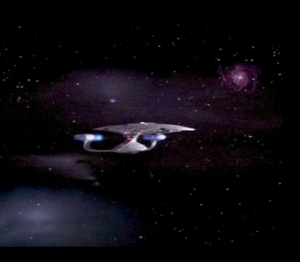|

In Star Trek, the Amargosa Diaspora is an enormous
globular cluster of unusually high density. One of its formations is
FGC 13, a stellar cluster. In 2369, the USS Enterprise-D was assigned
to chart this region. To expedite the process, Lieutenant Commander
Geordi La Forge devised a way to enhance the long-range sensors by
transferring warp power to the main deflector grid. His modifications
attracted the attention of solanagen-based lifeforms to the ship. (TNG:
"Schisms"). Amargosa was the primary star of the Amargosa system,
studied by a Federation observatory where Dr. Tolian Soran developed
his trilithium weapon. From the observatory, Soran launched the weapon
into Amargosa in 2371 and collapsed the star, producing a level-12
shock wave that destroyed everything in the system. The collapse of
Amargosa had several repercussions in its sector of space. These
effects included an increase in gamma emissions of .05%, gravitational
forces were altered, forcing the USS Bozeman to make a minor course
correction. The same forces altered the flight path of the Nexus ribbon
as Soran had planned, as part of his attempt to bring the ribbon to a
planet. (Star Trek Generations). It is unknown if the collapse of the
Amargosa star developed a quantum singularity, a dwarf star, or
completely destroyed it.
The word diaspora refers to the the spatial property of
being scattered about over a range or area. There is no such globular
cluster as the Amargosa Diaspora in real astronomy. However, the
jumbled rocks of the Virgin Spring area in the Black Mountains is
complexly faulted and folded, and this part of Death Valley has been
named by geologists as the ‘Amargosa chaos'. These multi-colored and
oddly-shaped mountains look as if Mother Nature had scattered and
thrown them together in a most twisted and random manner.
The FGC referred to in FGC 13 stands for Federation
General Catalogue. The real-science equivalent is NGC (New General
Catalogue) - a well-known catalogue of deep sky objects in amateur
astronomy. NGC 13 in this catalogue is a spiral galaxy in the Andromeda
constellation.
|
|
